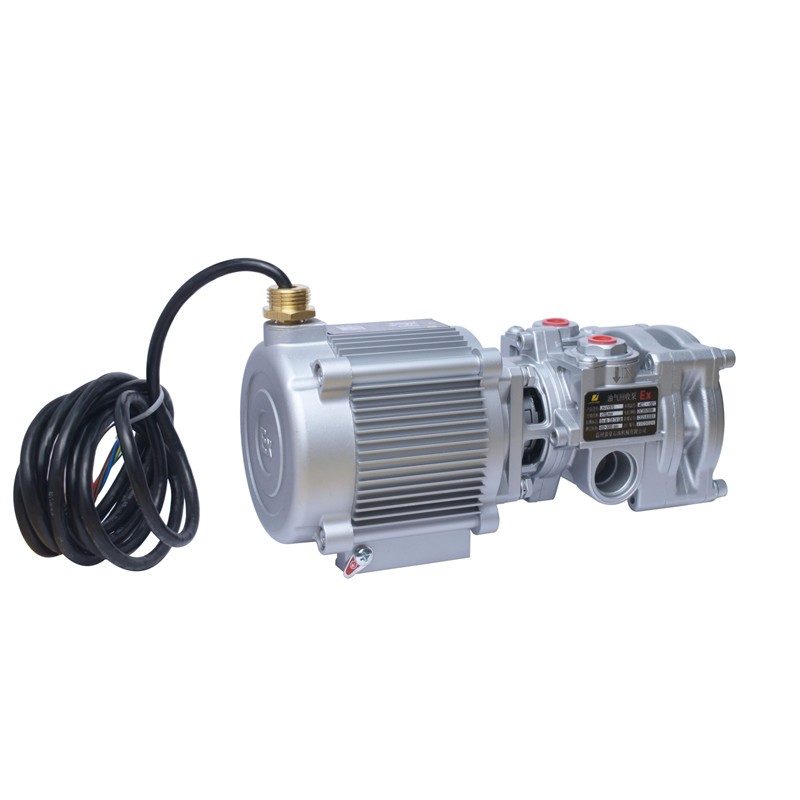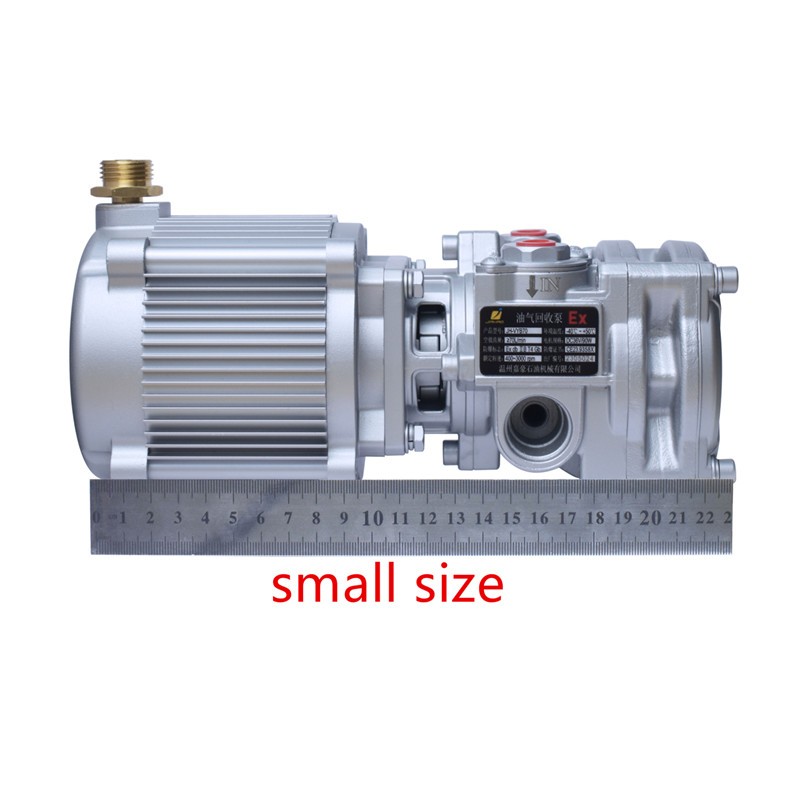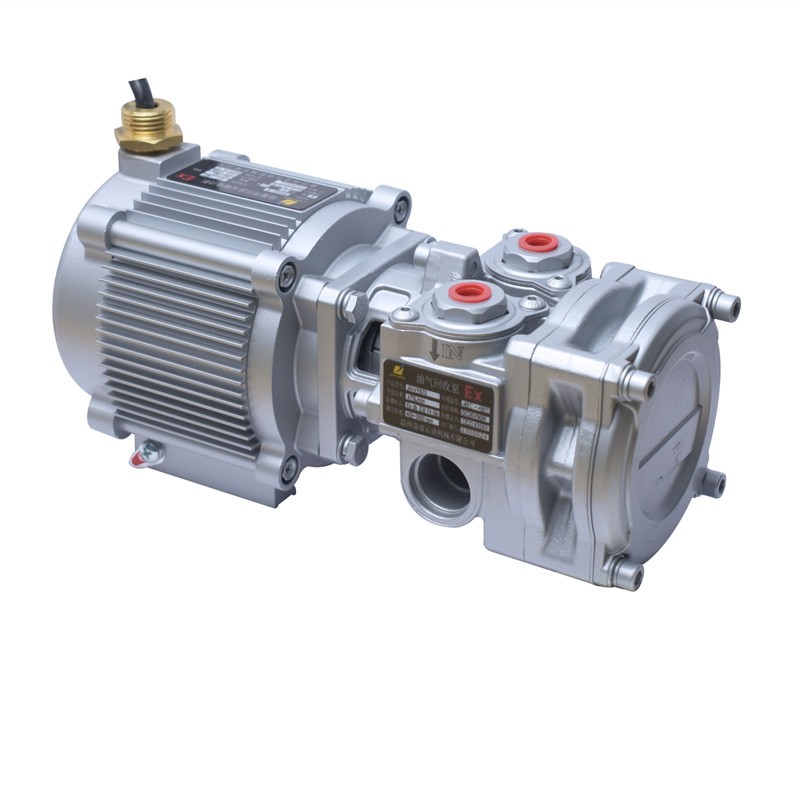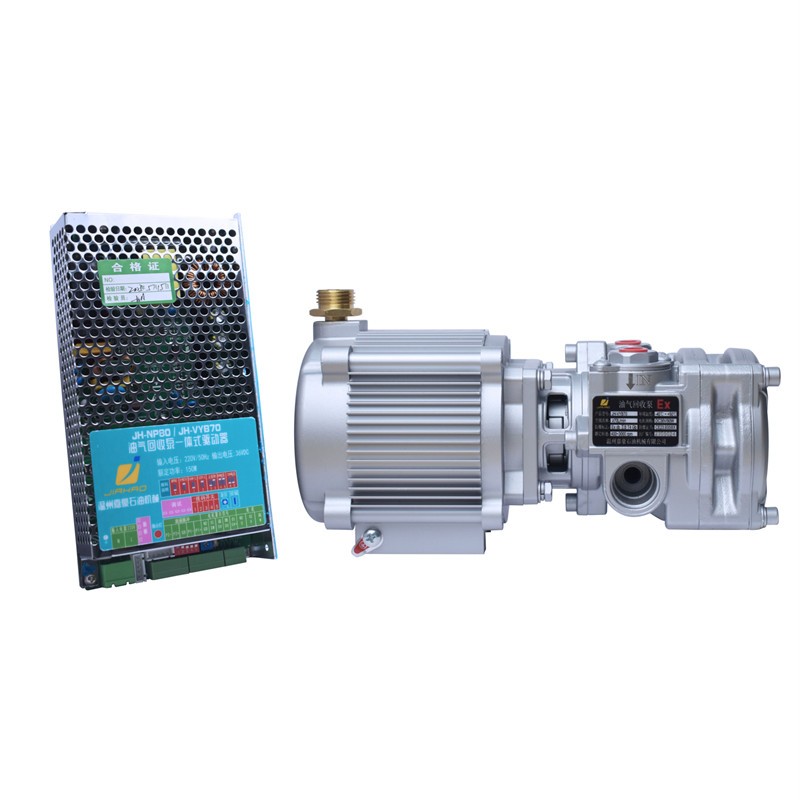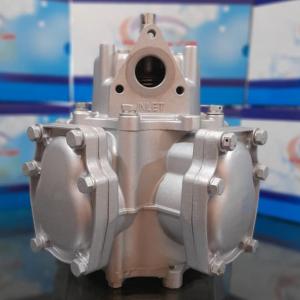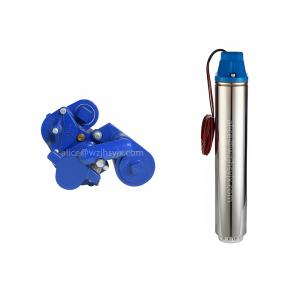شرح
vapor recovery vacuum pump frequency conversion
The advantages of this pump are small size, extremely low noise, and no vibration during operation. vapor recovery vacuum pump frequency conversion
The motor is a brushless DC motor. The coil of the motor is a triangular winding or a star winding. There are sensors inside the motor that indicate the position of the rotor and provide feedback on the speed of the motor.
In some specific motors, temperature sensors are also used to detect the internal temperature of the motor to prevent overheating.
I. Overview:
1.1 The explosion-proof performance of the vapor recovery vacuum pump in line with GB/T 3836.1-2021 explosive environment with Part 1: equipment General requirements, GB/T 3836.2-2021 explosive environment Part 2: by the explosion-proof shell "d" protection of the equipment, made of explosion-proof type. Explosion-proof mark for Ex db IIB T4 Gb, suitable for factory IIA, IIB class, temperature group T1-T4 group of combustible gases or vapours and air to form explosive gas mixtures in the place, the product electrical performance of the implementation of the provisions of Q/WJH 18-2022 "Vapor recycling vacuum pump".
1.2 The pump has the features of small size, light weight, long life, low noise, beautiful and generous modelling.
1.3 Pumps and motors of the relevant technical data, drawings and prototypes are examined by the explosion-proof electrical examination and inspection, and obtain the explosion-proof inspection unit issued by the "explosion-proof certificate of conformity".
Second, the significance of the type, explosion-proof marking, basic parameters
2.4 Basic technical characteristic parameters of electric motors
2.4.1 Control section parameters:
Supply voltage: 220VAC ± 15%
Input current: 1.0 A
Power: 200 W
Output voltage: 36VDC ± 15%
2.4.2 Parameters of variable frequency Vapor recovery vacuum pump.
Input voltage: 36 VDC ± 15%
DC inverter power: 90 W
Speed: 400 ~ 3000 rpm
Noise: 65dB (A)
Rated flow rate: 70L/min (no load)
Vacuum degree: ≤-0.055MPa
Explosion-proof marking: Ex db IIB T4 Gb
Shell protection grade: IP55
2.4.3 Working and environmental conditions
Ambient temperature: -40℃~50℃;
Relative humidity: 10 to 90 per cent;
Atmospheric pressure: 86kPa~106kPa.
Scope of application: Zone 1 and Zone 2 places containing explosive gas mixtures of class ⅡA and ⅡB, group T1 to T4;
III. Structural type:
3.1 The external dimensions and installation dimensions of the Vapor recovery vacuum pump are shown in Figure 1.
3.2 The insulation class of the motor is class F.
3.3 The temperature rise of the motor stator windings is 80K (resistance method) and the bearing temperature is 95°C (thermometer method).
3.4 Motors with deep groove ball bearings 6201-2RZ and 6202-2RZ (skf).
3.5 The components that make up the explosion-proof housing of the motor are: motor front cover, motor rear cover, motor housing, cable sealing ring, cable compression nut.
3.6 Components of explosion-proof shell, such as motor front and rear end caps, motor shell, etc., need to be qualified by 1.5MPa hydrostatic pressure test over 10+20 S after processing. The number of fastening bolts connecting the explosion-proof shell is indispensable to withstand the explosion pressure, and each bolt and nut is equipped with a spring washer to prevent self-loosening, and care should be taken to prevent arbitrary loosening.
3.7 The motor is a totally enclosed, self-fan-cooled IC411 with internal circulation ventilation.
3.8 The Vapor recovery vacuum pumps have an enclosure protection rating of IP55.
3.9 The motor is connected to the pump by means of a coupling, the motor having a cylindrical shaft protruding from the coupling.
3.10 The wiring out of the motor is of direct lead-in type. Cable for nine-core cable, the minimum introduction of the cable outer diameter of 6 ~ 6.5mm, the cable directly from the motor internal lead, power cable for 4x1mm2 cable which a yellow and green dual-coloured for grounding special (has been properly grounded inside the motor); Hall signal for 5x0.2mm2 shielded cables, the cable introduction in line with the requirements of the GB / T 3836.1-2021 Appendix A.
3.11 Motor Wiring and Setup
The motor is a brushless DC motor. The motor's coil is either a triangular winding or a star winding. There are sensors inside the motor to indicate the position of the rotor and to give feedback on the speed of the motor. In some specific motors there is also a temperature sensor to detect the internal temperature of the motor to prevent it from overheating.
3.11.1 Motor power connection 4x1mm2
The power supply of the motor is divided into U-phase, V-phase, W-phase and ground DC power, U-phase, V-phase and W-phase are connected from the three pins of the interface of the main board of the Vapor recovery pump respectively, and the earth wire is connected with the "Ground Marking Whammy" as shown in the table below:
|
pin number |
Wiring Colours |
functionality |
|
Brown U |
coir (coconut fiber) |
Motor U-phase DC power supply |
|
Red V |
bonus |
Motor V-phase DC power supply |
|
Blue W |
indigo plant |
Motor W-phase DC power supply |
|
confiscation of weapons |
Yellow/Green |
earth (electric connection) |
3.11.2 Motor Transmission Hall Wiring 5x0.2mm2
The rotor position Hall sensor for the motor is accessed from the corresponding interface of the Vapor recovery drive, see table below:
|
pin number |
Wiring Colours |
functionality |
|
White 5V |
spoken lines in opera |
Sensor power supply:+5VDC |
|
Black SU |
sinister |
Rotor SU position sensor |
|
Blue SV |
indigo plant |
Rotor SV position sensor |
|
Red SW |
bonus |
Rotor SW position sensor |
|
Brown GND |
coir (coconut fiber) |
Sensor GND |
IV. Installation, operation and use
4.1 The ambient air temperature is -40°C to +50°C.
4.2 The explosion-proof level and temperature group of the Vapor recovery vacuum pumps are in accordance with the requirements for explosive gas environments.
4.3 Before installation, the following items should be checked to see if they meet the requirements, and if they do not, they are not allowed to be used.
4.4 The data on the proofreading nameplate should fulfil the requirements for use.
4.5 With explosion-proof marking and explosion-proof certificate number.
4.6 All fasteners are not missing and explosion-proof enclosure parts are properly connected.
4.7 The Vapor recovery vacuum pump (half a year and above) which has been transported over a long distance or left unused for a long period of time should be used to measure the insulation resistance between the stator winding and the casing with a megohmmeter of 500 volts, which should be not less than 50MΩ when the rated voltage is 220V, otherwise the motor should be dried until the insulation resistance is qualified. The drying method: can be connected to the heater or with incandescent lamps or infrared heating, heating should make the winding resistance temperature gradually increase, but not more than the insulation level of the value specified by 135 ℃.
4.8 The internal grounding should be reliably connected to the internal grounding screw through the power supply PE wire, and there are anti-loosening and anti-corrosion measures; the external grounding of the equipment should be reliably connected to the site grounding stake through the yellow-green grounding wire of not less than 4mm .2
4.9 The maximum temperature of the surface of the motor casing of the Vapor recovery vacuum pump shall not exceed 130°C during normal operation.
4.10 It is strictly prohibited to open the cover and disassemble with electricity.
4.11 The difference between the minimum diameter of the cable and the inner diameter of the introduction device seal is not more than 1 mm.
4.12 The installation and use of Vapor recovery vacuum pumps shall comply with the requirements of GB/T 3836.15-2017 "Explosive Environment Part 15: Design, Selection and Installation of Electrical Installations".
V. Maintenance and repair
5.1 The pump should be inspected and cleaned regularly, no dust should accumulate on the surface of the casing, the surface of the product should be cleaned with a fluffy cloth, and the motor should not be cleaned by spraying with a tap.
5.2 The permissible temperature of the bearings during pump operation must not exceed 95°C (thermometer method).
5.3 When the radial clearance of the bearing reaches 0.1mm, the bearing should be replaced.
5.4 It is strictly prohibited to disassemble the pump motor at will, when the motor must be disassembled, attention should be paid to the protection of the explosion-proof surface, when assembling the processing with the surface coated with industrial petroleum jelly, the explosion-proof surface coated with 204-1 antirust oil, and all the explosion-proof surface shall not be damaged and corroded, in order to ensure the performance of the explosion-proof. Attention should be paid to protect the stator winding. Non-professionals are prohibited to disassemble.
5.5 The insulation resistance between the stator windings and between the stator windings and the casing shall be measured before use of the dismantled motor and shall be not less than 100MΩ.
5.6 The pump inlet and outlet flame arresters should be checked regularly, and foreign matter and dust on the surface of the flame arresters should be cleaned up in time to prevent affecting the gas flow and the service life of the pump, and the pump should be inspected and cleaned up once in 6 months in general.
5.7 When the pump appears high flow rate refuelling gas-liquid ratio qualified, low flow rate refuelling gas-liquid ratio deviation, should be promptly cleaned up the pump chamber and vane.
5.8 The rubber ring should be replaced promptly after deterioration.
5.9 The inspection and maintenance of the Vapor recovery vacuum pump shall be in accordance with the requirements of GB/T 3836.16-2017 "Explosive Environment Part 16: Inspection and Maintenance of Electrical Installations".
5.10 The overhaul of the Vapor recovery vacuum pump shall comply with the requirements of GB 3836.13-2013 "Explosive Environment Part 13: Repair, Overhaul, Restoration and Modification of Equipment".
5.11 Operators of the product should be trained in explosion protection.
